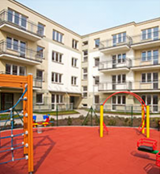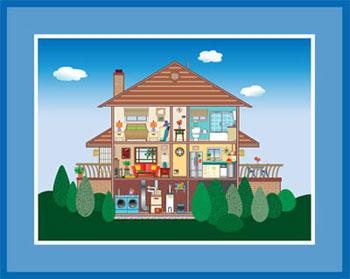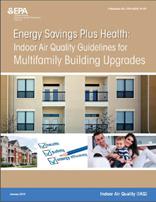Protect Indoor Air Quality in Your Home
Whether you live in an apartment, townhouse or single family home, an old home or are building a new home, there are many ways to protect and improve your indoor air quality.
Indoor pollution sources that release gases or particles into the air are the primary cause of indoor air quality problems in homes. Inadequate ventilation can increase indoor pollutant levels by not bringing in enough outdoor air to dilute emissions from indoor sources and by not carrying indoor air pollutants out of the home. High temperature and humidity levels can also increase concentrations of some pollutants.
The resources on this page will help you take immediate steps to protect IAQ in your home and prevent IAQ problems during remodels or renovations or when building a new home. You can also find resources to help building professionals and residents protect IAQ in multiifamily buildings.
What You Can Do Now
- Test for radon or determine how to fix high levels of radon.
- Reduce asthma triggers.
- Prevent mold by controlling moisture.
- Keep your home and car smoke-free.
- Install carbon monoxide (CO) alarms. Change the batteries in existing CO and smoke detectors.
- Use and properly maintain your ventilation system.
Home Remodels and Energy Upgrades
The benefits of home upgrades are tremendous — improving quality of life for occupants, protecting the environment, and sustaining American jobs. Integrated healthy home and energy efficiency upgrade activities can simultaneously lower utility costs and improve indoor air quality. Leading energy efficiency upgrade programs have demonstrated the feasibility of integrating many indoor air quality and safety improvements. However, home energy upgrade and other remodeling and repair activities might negatively affect indoor air quality if the appropriate home assessment is not made before work begins or if work is performed improperly.
- Read the latest guidance on protecting IAQ during energy upgrades and other remodels.
- Specific Home Remodel Environmental Concerns:
- What to Do When Remodeling Your Space:
- Building a Home Addition?
- IAQ Best Practices for Remodeling:
- Save Energy while creating a healthier home.
Multifamily Housing
In the U.S. one out of five people -- about 80 million -- live in some type of multifamily building. These structures are often referred to as "multi-unit housing" or "multi-housing" and include:

- Attached townhouses
- Low-rise apartments and condos
- Mid-rise apartments and condos
- High-rise apartments and condos
Multifamily buildings pose unique indoor air quality (IAQ) challenges because pollutants may move from unit to unit and residents have limited ability to make changes to the building structure itself.
Comprehensive Indoor Air Quality in Multifamily Buildings
- Energy Savings Plus Health Indoor Air Quality Guidelines for Multifamily Building Upgrades. New EPA guidance for everyone involved in energy and other building upgrades in mutlifamily housing.
- DOE Multifamily Guidelines for Home Energy Professionals Exit
Radon
- EPA Radon Guide for Tenants: This guide is for people who rent their apartments or houses. The guide explains what radon is, how to find out if there is a radon problem in your home and what you can do if there are high radon levels in your home.
- Radon-resistant construction: Low-Rise Multi-Family Housing (PDF) Exit(4 pp, 78 K). This fact sheet is intended to provide a basic understanding of strategies to reduce radon levels for people involved with the design and construction of low-rise (three stories or less) multi-family buildings. Produced by the National Center for Healthy Housing (NCHH)
- 2013 Housing Notice to include radon assessment in the Multifamily Accelerated Processing (MAP) Guide. Issued in 2013 by the U.S. Housing and Urban Development (HUD)
- HUD Radon Policy Notice (PDF)(7 pp, 197 K). Notice H 2013-03 Exit
- HUD Mortgage Letter (PDF)(7 pp, 197 K) 2013-07 January 31, 2013 Exit
- Radon Testing and Mitigation Standards for Multifamily Buildings. American National Standards Institute (ANSI) – American Association of Radon Specialists and Technologists (AARST). For a fee, order a copy from the AARST Bookstore. Exit
Smoke-Free Policies
- Change Is In the Air (PDF)(100 pp, 2.3 MB) Exit: An Action Guide for Establishing Smoke-Free Policies in Public Housing and Multifamily Properties by the U.S. Housing and Urban Development (HUD)
- Smoke-Free Toolkits Exit: Toolkits for residents and owner/managers who live, and work, in federally assisted housing. Created by U.S. Housing and Urban Development (HUD)
- Healthy Homes Manual on Smoke-Free Policies In Multiunit Housing (PDF)(40 pp, 7 MB) Exit. This manual is designed for state and local healthy Homes program that are working to reduce secondhand smoke exposure in multiunit housing. The manual provides field tested strategies, recommendations, best practices and tools. Created by the Centers for Disease Control and Prevention (CDC)
Pest Management
Build Your New Home with Improved IAQ
- Build an Indoor airPLUS Qualified New Home
- Build Using Radon-Resistant New Construction (RRNC) Techniques


